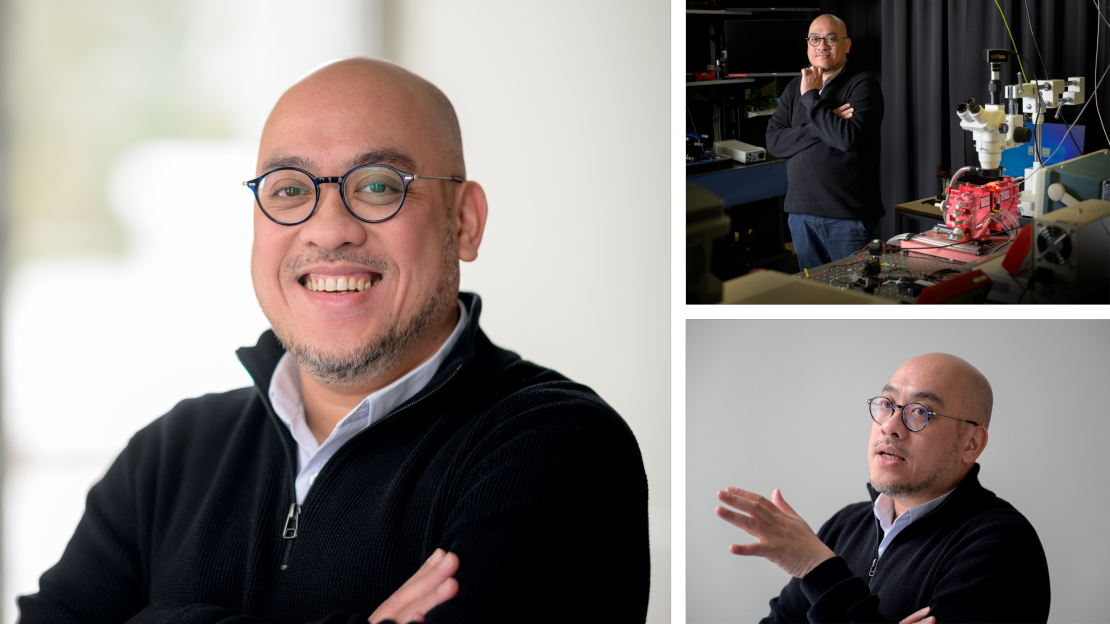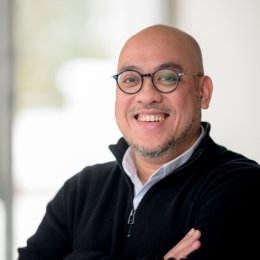Optics, acoustics, and electronics in integrated circuits
By introducing sound waves in photonic integrated circuits, Professor David Marpaung works at the intersection of optics, electronics and acoustics. Marpaung and his team demonstrated an elegant proof of principle that they are now developing into mature applications.
In theory, the sound waves help to achieve a much higher precision and resolution to process information, but the fabrication of chips is not straightforward. ‘Acoustics is funny,’ says David Marpaung. ‘Sound waves are slow and need a medium to propagate. It’s that slowness that allows for enhanced precision in information transfer, which is why we want to use them in chips.’
Marpaung’s work is all about integrated circuits (ICs) or chips that are indispensable in computers, mobile phones and all other technology in modern life. Over time, chips have become much smaller and faster. A major improvement to the current electricity-based technology is the so-called photonic chip that transports information with light, through optical channels or waveguides. This allows for even faster information processing with a lower energy consumption. It may seem a bit counter-intuitive that the next step in enhancing IC technology is to introduce sound waves that are relatively slow, but this is exactly what professor Marpaung aims to do.
‘Sound waves can’t respond to everything an optical signal responds to, which makes it possible to filter out noise and increase the precision of information transfer,’ says Marpaung. ‘For this, it is essential for light and sound to interact, but light and sound need different materials and conditions to propagate properly. We tackled this by manipulating the standard design of photonic chips.’
Waveguides in photonic chips are usually composed of a solid silicon nitride core surrounded by a glass mantle that keeps light inside the core. But because sound waves prefer to travel through the glass, they will not interact with the light in such a chip. Marpaung and his team solved this problem by creating a waveguide that contains not one but two cores of silicon nitride inside the glass mantle. ‘Light traveling through these cores will leak a bit into the glass in between,’ he explains. ‘If we create a sound wave in this area, it is guided well by the glass and interacts with the light signal as well.’
With their novel waveguide design, Marpaung and his group are taking the next steps towards commercial application of sound in integrated circuits. ‘We are currently investigating various different designs based on this principle,’ says Marpaung who has received an ERC consolidator grant for the project in 2022. ‘We are testing our ceiling here. We work hard to find the best materials for an integrated circuit for light and sound, but we also think about spin-offs and patents, because we wish to actually apply this technology in the chips of tomorrow.’
The group also has close connections with the industry through the UT based IC company LioniX. Marpaung: ‘We want to unravel the fundamental physics behind the interaction of light and sound, but we always keep application of the technology in mind.’
Education
David Marpaung has warm memories of several people that were a mentor or a guide for him throughout his career and it is his mission to be such a mentor for the younger people in his group now. ‘When it comes to guiding people, the human element is as important as the scientific part,’ he says.
Apart from this day to day mentoring of undergraduate students and PhD students, Marpaung also developed and teaches courses on small signals and detection and on integrated photonic systems, that are part of the Applied Physics Master Program. ‘I think it should be our aim to deliver graduates that have the skills that the industry needs,’ says Marpaung. ‘We aim high scientifically, but I also strive for personal excellence for every member of our group. Each student that leaves should be an ambassador for how serious we are in our group and at this university.’
About David Marpaung
As a Bachelor student of Physics in Indonesia, David Marpaung won a scholarship that enabled him obtain his Masters’ degree in the Netherlands where he studied Applied Physics at the University of Twente. After a year in his home country, he came back for a PhD in Electrical Engineering. ‘This gave me a big network in Twente,’ says Marpaung, who worked as a (senior) research fellow at the University of Sydney, before returning to Twente in 2018. He now leads the Nonlinear Nanophotonics group in the Faculty of Science and Technology. Marpaung received several honors and awards for his work, among which a NWO Vidi grant in 2017 and ERC consolidator grant in 2022. He is also part time adjunct professor at the Bandung Institute for Technology, where he started his studies twenty-five years ago.
Press photos

These press photos can be used without copyright restrictions.


